Everything You Need to Know About San Fermín
The Festival That Inspired Hemingway
Everything You Need to Know About San Fermín
The Festival That Inspired Hemingway
What is San Fermín?
San Fermín is more than a festival — it’s a centuries-old cultural celebration in Pamplona, Spain, that blends tradition, adrenaline, and joy. Every July, thousands gather to run with the bulls, dance in the streets, and celebrate life in a way that has inspired the world — including Ernest Hemingway.
History and Origins
Its origins date back to medieval religious processions honoring Saint Fermín, the city’s patron saint. Over time, it evolved into one of the world’s most iconic festivals — especially after Ernest Hemingway captured its spirit in his novel The Sun Also Rises, making San Fermín a bucket-list experience for adventurous travelers around the globe.
Today, San Fermín is more than just a festival — it’s a way of life that unites locals and visitors in an unforgettable celebration of culture, courage, and community.
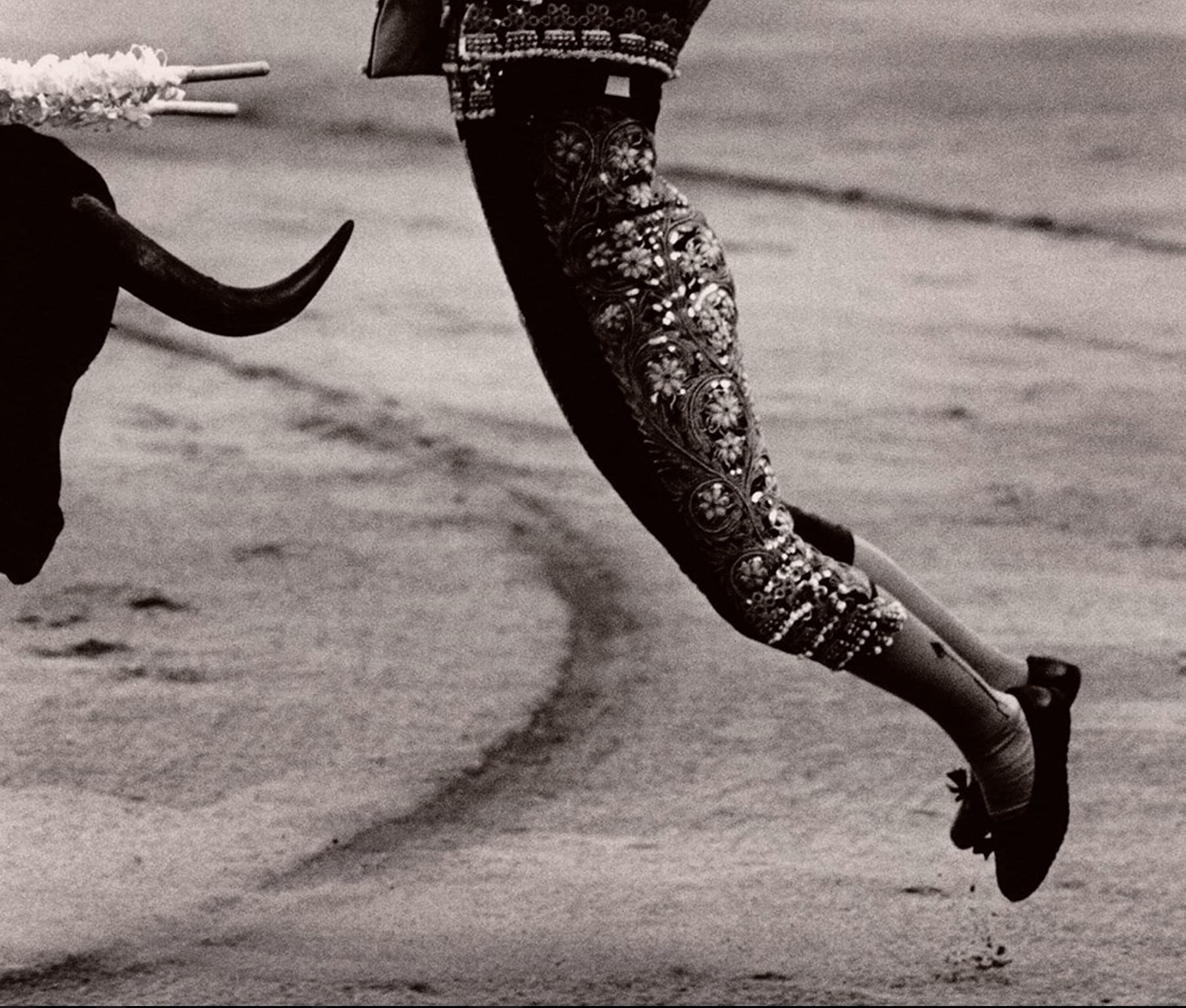
The Running of the Bulls
What It Is, How It Works, and Why People Still Run
The Running of the Bulls, or El Encierro, is the most iconic — and adrenaline-filled — event of San Fermín. Every morning from July 7–14 at 8:00 AM, hundreds of runners (locals and brave visitors) take to the narrow streets of Pamplona, leading six fighting bulls through an 875-meter route that ends in the bullring.
It lasts just a few minutes, but it’s pure intensity: tradition, fear, excitement, and respect all rolled into one. Originally, the run was simply how bulls were transported from the corrals to the ring. Today, it’s a deeply symbolic act — part local rite of passage, part global spectacle.
IMPORTANT TO KNOW
Running is risky and not recommended without preparation. Many travelers choose to watch safely from a private balcony, with a full view of the action and local guidance.
The Running of the Bulls
The Running of the Bulls
1. When is the Running of the Bulls in Spain?
The Running of the Bulls takes place every year from July 7th to July 14th in Pamplona, Spain as part of the San Fermín Festival.
2. Where is the Running of the Bulls held?
The Running of the Bulls takes place in Pamplona, a historic city in Navarre, northern Spain, during the San Fermín Festival.
3. What time does the Running of the Bulls start each day?
The Running of the Bulls starts every morning at 8:00 AM sharp, with the bulls running through the streets of Pamplona.
4. How can I watch the Running of the Bulls?
You can safely watch the Running of the Bulls from private balconies along the route or from designated viewing areas in the city.
5. Why do they run with the bulls in Spain?
The Running of the Bulls is a tradition rooted in medieval times to transport bulls to the bullring, now a symbol of courage, adrenaline, and culture.
6. How much does it cost to run with the bulls?
There is no cost to run with the bulls, but participants must register for the San Fermín festival, and some events may require tickets for spectators.
7. Is it safe to run with the bulls?
Running with the bulls carries risks, but safety measures are in place. First-time runners are advised to watch the event first and follow local safety guidelines.
8. Can I bring my kids to the Running of the Bulls?
While the Running of the Bulls is not child-friendly, families can enjoy other San Fermín events like the parades and traditional dances.
9. What should I wear to the Running of the Bulls?
Participants wear traditional white clothing with a red scarf to honor San Fermín. Comfortable shoes are essential for safety during the run.
10. What happens during the Running of the Bulls?
Runners race alongside six bulls as they charge through Pamplona’s narrow streets, from the corral to the bullring, for an adrenaline-pumping 2–3 minute experience.
11. Can I watch the bullfight after the run?
Yes, after the Running of the Bulls, the bulls are fought in the bullring in the afternoon. Tickets for the bullfight are sold separately.
12. How can I experience the Running of the Bulls on a budget?
Watching the Running of the Bulls from a balcony is the safest option, but there are budget-friendly experiences, such as attending the San Fermín street parties and parades.
More Must-See Events at San Fermín
San Fermín in Pamplona is much more than just the daily bull runs — it’s a vibrant, week-long celebration filled with music, tradition, parades, and emotional rituals. From candlelit ceremonies to giant puppet processions, these unforgettable cultural moments will give you a deeper, more meaningful connection to one of Spain’s most iconic festivals. Here are the top events at San Fermín you won’t want to miss:
El Chupinazo – Opening Ceremony
JULY 6 AT 12:00 PM
The San Fermín Festival officially kicks off on July 6th at 12:00 PM with one of the most electrifying events of the entire celebration — El Chupinazo. This thrilling opening ceremony takes place right in front of Pamplona’s City Hall (Ayuntamiento), where thousands of people, both locals and international visitors, come together to witness the launch of a single rocket that signals the beginning of nine unforgettable days of festivities. The atmosphere is electric and filled with anticipation.
As the Chupinazo rocket explodes in the sky, the crowd erupts into celebration. Dressed in the iconic red and white attire of San Fermín, participants cheer, sing, dance, and spray champagne into the air. It’s a chaotic yet joyful moment that perfectly captures the spirit of the festival. For many American travelers visiting Spain in July, attending the Chupinazo is a bucket-list experience — a once-in-a-lifetime cultural event filled with tradition, excitement, and high energy.
If you’re planning to attend the Running of the Bulls in Pamplona, make sure to arrive early for the Chupinazo. This unique ceremony not only marks the official start of the festivities, but also immerses you in the passion and camaraderie that defines San Fermín in Spain. It’s the perfect introduction to a week of bull runs, parades, live music, and Spanish cultural heritage — and a must-see for any adventurous traveler.
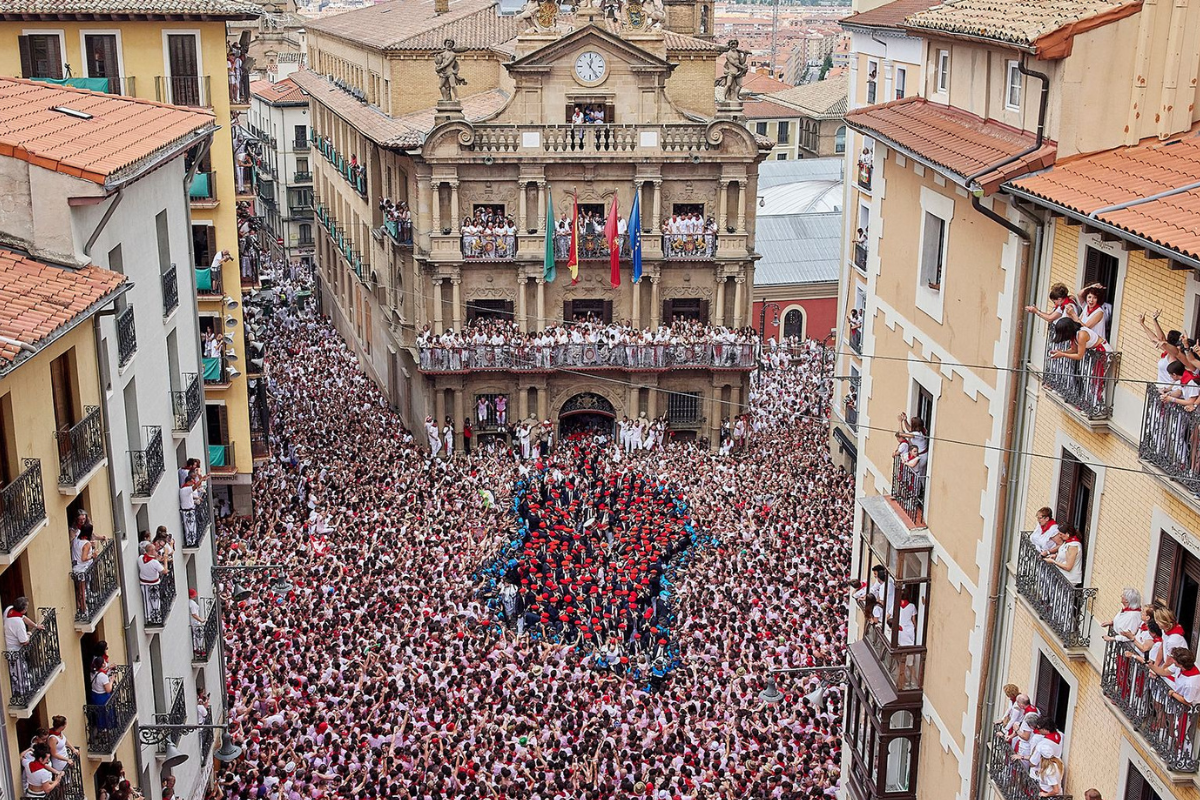
El Chupinazo – Opening Ceremony
JULY 6 AT 12:00 PM
The San Fermín Festival officially kicks off on July 6th at 12:00 PM with one of the most electrifying events of the entire celebration — El Chupinazo. This thrilling opening ceremony takes place right in front of Pamplona’s City Hall (Ayuntamiento), where thousands of people, both locals and international visitors, come together to witness the launch of a single rocket that signals the beginning of nine unforgettable days of festivities. The atmosphere is electric and filled with anticipation.
As the Chupinazo rocket explodes in the sky, the crowd erupts into celebration. Dressed in the iconic red and white attire of San Fermín, participants cheer, sing, dance, and spray champagne into the air. It’s a chaotic yet joyful moment that perfectly captures the spirit of the festival. For many American travelers visiting Spain in July, attending the Chupinazo is a bucket-list experience — a once-in-a-lifetime cultural event filled with tradition, excitement, and high energy.
If you’re planning to attend the Running of the Bulls in Pamplona, make sure to arrive early for the Chupinazo. This unique ceremony not only marks the official start of the festivities, but also immerses you in the passion and camaraderie that defines San Fermín in Spain. It’s the perfect introduction to a week of bull runs, parades, live music, and Spanish cultural heritage — and a must-see for any adventurous traveler.

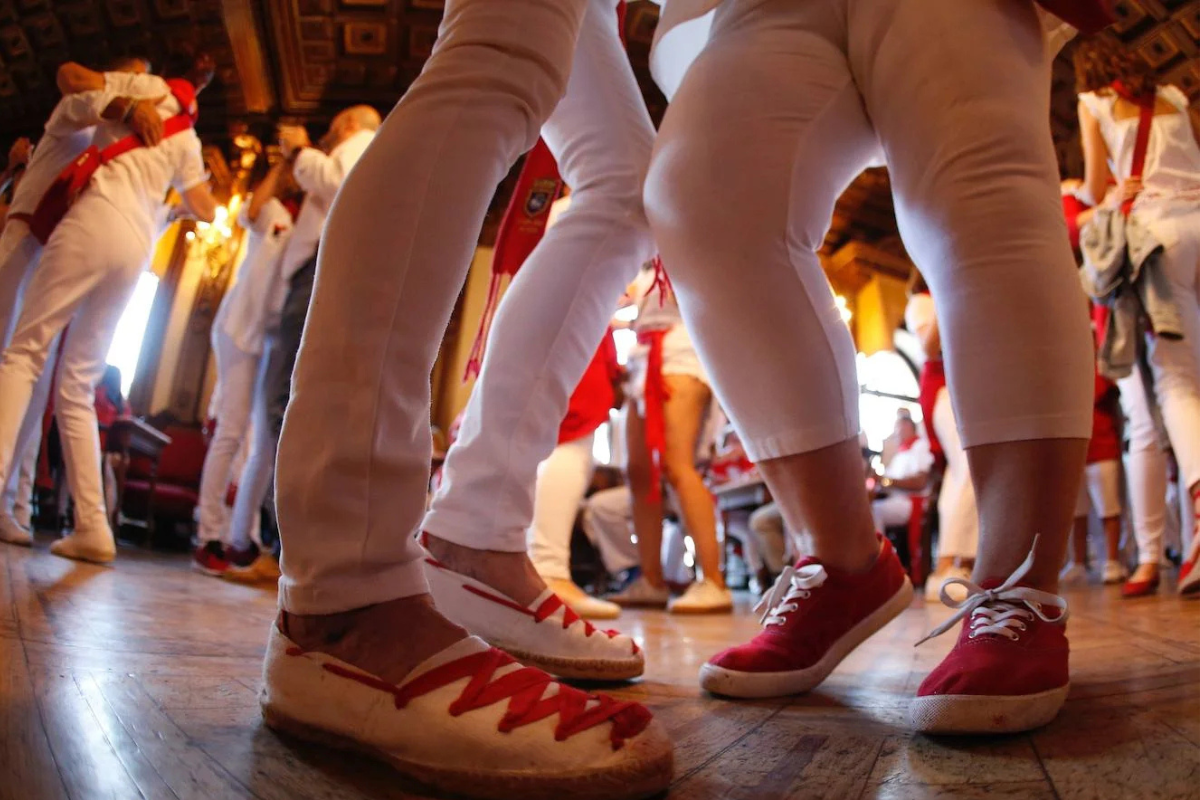
Baile de la Alpargata – Morning Dancing Tradition
EVERY MORNING AFTER THE BULLFIGHTS
After the adrenaline of the Running of the Bulls, the streets of Pamplona don’t rest — they come alive in a different way. Every morning, as the sun rises over the cobbled streets, locals gather in traditional Navarrese attire to celebrate their heritage through dance, song, and community. It’s a powerful reminder that San Fermín is more than just the bull runs — it’s a vibrant cultural tradition passed down through generations.
Wearing traditional white outfits with red sashes and neckerchiefs, locals — often joined by curious and respectful visitors — fill the plazas with folk music, laughter, and joy. These post-encierro mornings are a chance to see the authentic Pamplona lifestyle, far from the tourist lens. You’ll witness centuries-old dances, live bands, and spontaneous parades that reflect the deep-rooted identity of the region. It’s a side of San Fermín that many travelers overlook — but one that leaves a lasting impression.
For American visitors seeking more than just the thrill of the bulls, this is the perfect way to connect with Spanish culture on a deeper level. Join in the music, enjoy a local breakfast in the old town, and experience the true spirit of San Fermín — where tradition, community, and celebration merge in unforgettable moments that define the soul of Pamplona.
Baile de la Alpargata – Morning Dancing Tradition
EVERY MORNING AFTER THE BULLFIGHTS
After the adrenaline of the Running of the Bulls, the streets of Pamplona don’t rest — they come alive in a different way. Every morning, as the sun rises over the cobbled streets, locals gather in traditional Navarrese attire to celebrate their heritage through dance, song, and community. It’s a powerful reminder that San Fermín is more than just the bull runs — it’s a vibrant cultural tradition passed down through generations.
Wearing traditional white outfits with red sashes and neckerchiefs, locals — often joined by curious and respectful visitors — fill the plazas with folk music, laughter, and joy. These post-encierro mornings are a chance to see the authentic Pamplona lifestyle, far from the tourist lens. You’ll witness centuries-old dances, live bands, and spontaneous parades that reflect the deep-rooted identity of the region. It’s a side of San Fermín that many travelers overlook — but one that leaves a lasting impression.
For American visitors seeking more than just the thrill of the bulls, this is the perfect way to connect with Spanish culture on a deeper level. Join in the music, enjoy a local breakfast in the old town, and experience the true spirit of San Fermín — where tradition, community, and celebration merge in unforgettable moments that define the soul of Pamplona.

Street Parties & Live Music – All Week Long
After the adrenaline of the Running of the Bulls, the streets of Pamplona don’t rest — they come alive in a different way. Every morning, as the sun rises over the cobbled streets, locals gather in traditional Navarrese attire to celebrate their heritage through dance, song, and community. It’s a powerful reminder that San Fermín is more than just the bull runs — it’s a vibrant cultural tradition passed down through generations.
Wearing traditional white outfits with red sashes and neckerchiefs, locals — often joined by curious and respectful visitors — fill the plazas with folk music, laughter, and joy. These post-encierro mornings are a chance to see the authentic Pamplona lifestyle, far from the tourist lens. You’ll witness centuries-old dances, live bands, and spontaneous parades that reflect the deep-rooted identity of the region. It’s a side of San Fermín that many travelers overlook — but one that leaves a lasting impression.
For American visitors seeking more than just the thrill of the bulls, this is the perfect way to connect with Spanish culture on a deeper level. Join in the music, enjoy a local breakfast in the old town, and experience the true spirit of San Fermín — where tradition, community, and celebration merge in unforgettable moments that define the soul of Pamplona.
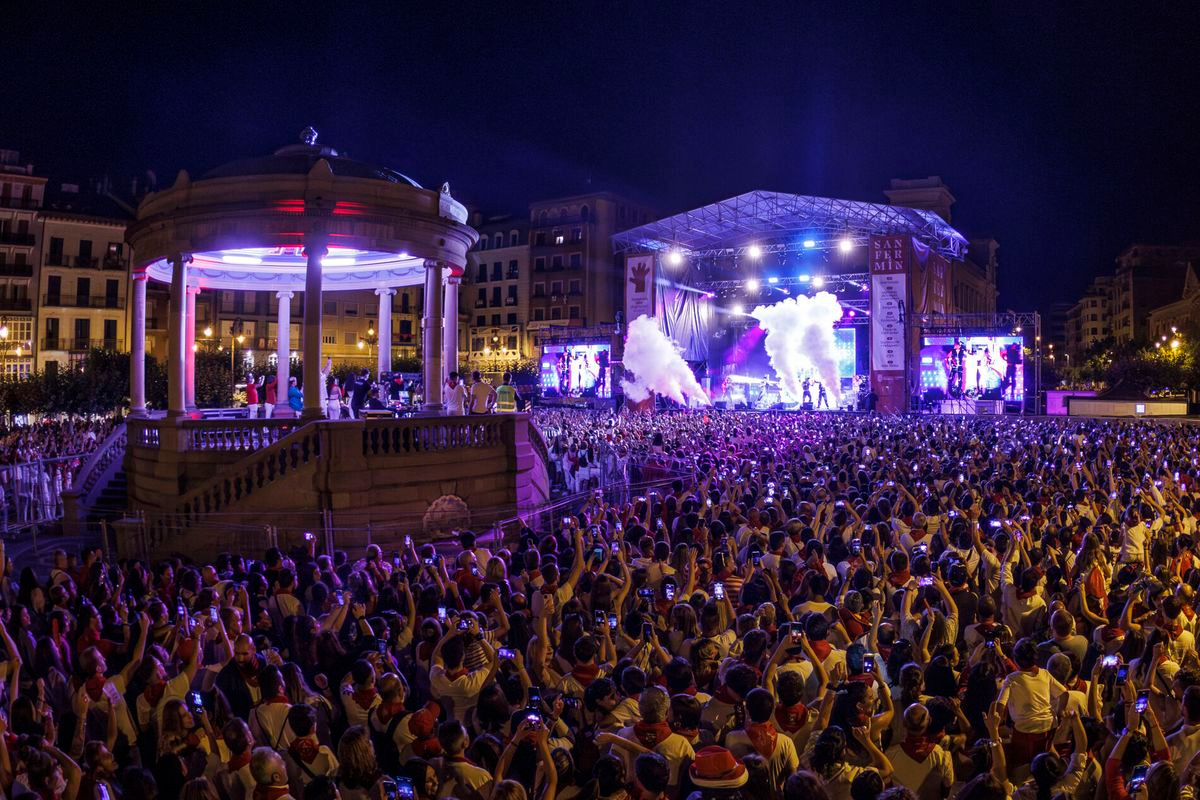
Street Parties & Live Music – All Week Long
After the adrenaline of the Running of the Bulls, the streets of Pamplona don’t rest — they come alive in a different way. Every morning, as the sun rises over the cobbled streets, locals gather in traditional Navarrese attire to celebrate their heritage through dance, song, and community. It’s a powerful reminder that San Fermín is more than just the bull runs — it’s a vibrant cultural tradition passed down through generations.
Wearing traditional white outfits with red sashes and neckerchiefs, locals — often joined by curious and respectful visitors — fill the plazas with folk music, laughter, and joy. These post-encierro mornings are a chance to see the authentic Pamplona lifestyle, far from the tourist lens. You’ll witness centuries-old dances, live bands, and spontaneous parades that reflect the deep-rooted identity of the region. It’s a side of San Fermín that many travelers overlook — but one that leaves a lasting impression.
For American visitors seeking more than just the thrill of the bulls, this is the perfect way to connect with Spanish culture on a deeper level. Join in the music, enjoy a local breakfast in the old town, and experience the true spirit of San Fermín — where tradition, community, and celebration merge in unforgettable moments that define the soul of Pamplona.

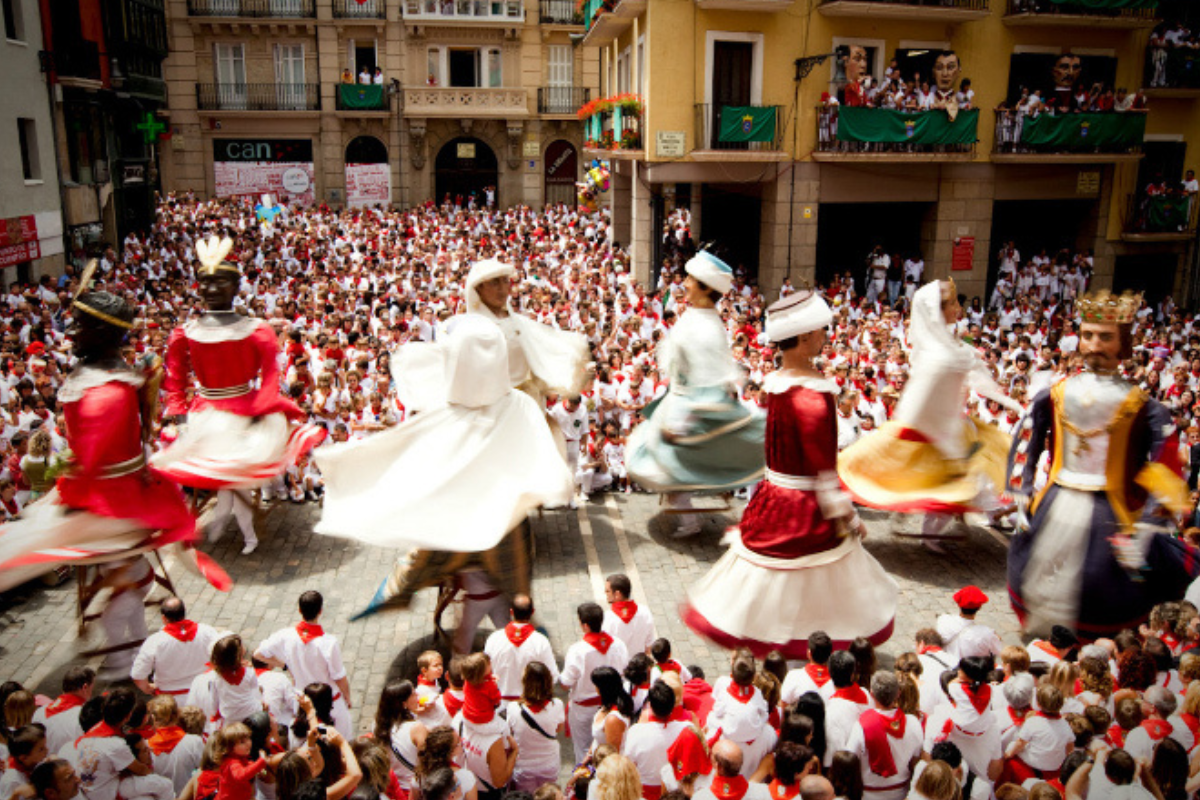
Processions & Giants Parade
One of the most beloved traditions of the San Fermín Festival is the daily Giants and Big-Headed Figures Parade (Desfile de Gigantes y Cabezudos). Every morning, enormous papier-mâché giants — known as Gigantes — dance through the streets of Pamplona, accompanied by traditional music and colorful processions. Towering up to 13 feet high, these figures represent different continents and cultures, and have been part of the festival for over 150 years.
The parade is especially popular with children, making it a perfect activity for families visiting Spain during San Fermín. The whimsical Cabezudos (big-headed characters) walk alongside the giants, playfully interacting with the crowd and keeping the mood joyful and lighthearted. It’s a magical experience that transforms the historic city center into a living stage, where tradition, artistry, and imagination come together in celebration.
For American travelers looking to experience authentic Spanish culture beyond the Running of the Bulls, this parade offers a heartwarming and visually stunning glimpse into local heritage. Whether you’re visiting Pamplona with kids or just want to witness something truly unique, the Gigantes y Cabezudos are a must-see part of the San Fermín festivities. It’s the kind of cultural moment that creates lifelong memories — and incredible photo opportunities.
Processions & Giants Parade
One of the most beloved traditions of the San Fermín Festival is the daily Giants and Big-Headed Figures Parade (Desfile de Gigantes y Cabezudos). Every morning, enormous papier-mâché giants — known as Gigantes — dance through the streets of Pamplona, accompanied by traditional music and colorful processions. Towering up to 13 feet high, these figures represent different continents and cultures, and have been part of the festival for over 150 years.
The parade is especially popular with children, making it a perfect activity for families visiting Spain during San Fermín. The whimsical Cabezudos (big-headed characters) walk alongside the giants, playfully interacting with the crowd and keeping the mood joyful and lighthearted. It’s a magical experience that transforms the historic city center into a living stage, where tradition, artistry, and imagination come together in celebration.
For American travelers looking to experience authentic Spanish culture beyond the Running of the Bulls, this parade offers a heartwarming and visually stunning glimpse into local heritage. Whether you’re visiting Pamplona with kids or just want to witness something truly unique, the Gigantes y Cabezudos are a must-see part of the San Fermín festivities. It’s the kind of cultural moment that creates lifelong memories — and incredible photo opportunities.

The End: Pobre de Mí
JULY 14 AT MIDNIGHT
At exactly midnight on July 14, the vibrant energy of San Fermín slows down for one final, emotional gathering: the Pobre de Mí ceremony. In a stark contrast to the explosive beginning of the festival, this closing event is quiet, reflective, and deeply moving. Locals and visitors meet once more in front of Pamplona’s City Hall, this time holding candles, as they sing the traditional song “Pobre de mí, pobre de mí, que se han acabado las fiestas de San Fermín” — “Poor me, the festival is over.”
The sea of candlelight, the gentle melody of the crowd, and the collective feeling of gratitude make this a moment that touches everyone present. For many, especially first-time visitors from abroad, it’s a powerful reminder of how meaningful this festival is to the people of Pamplona. This is not just the end of a party — it’s the end of a spiritual and cultural journey, shared with thousands of others who’ve come to love San Fermín in Spain.
If you’re an American traveler looking for more than just thrills, the Pobre de Mí ceremony offers a chance to connect deeply with the heart of the local community. It’s a moment to reflect, to give thanks, and to understand why Pamplona’s festival means so much to those who call it home. Don’t miss this unforgettable ending — it will leave you with goosebumps, and a desire to return.
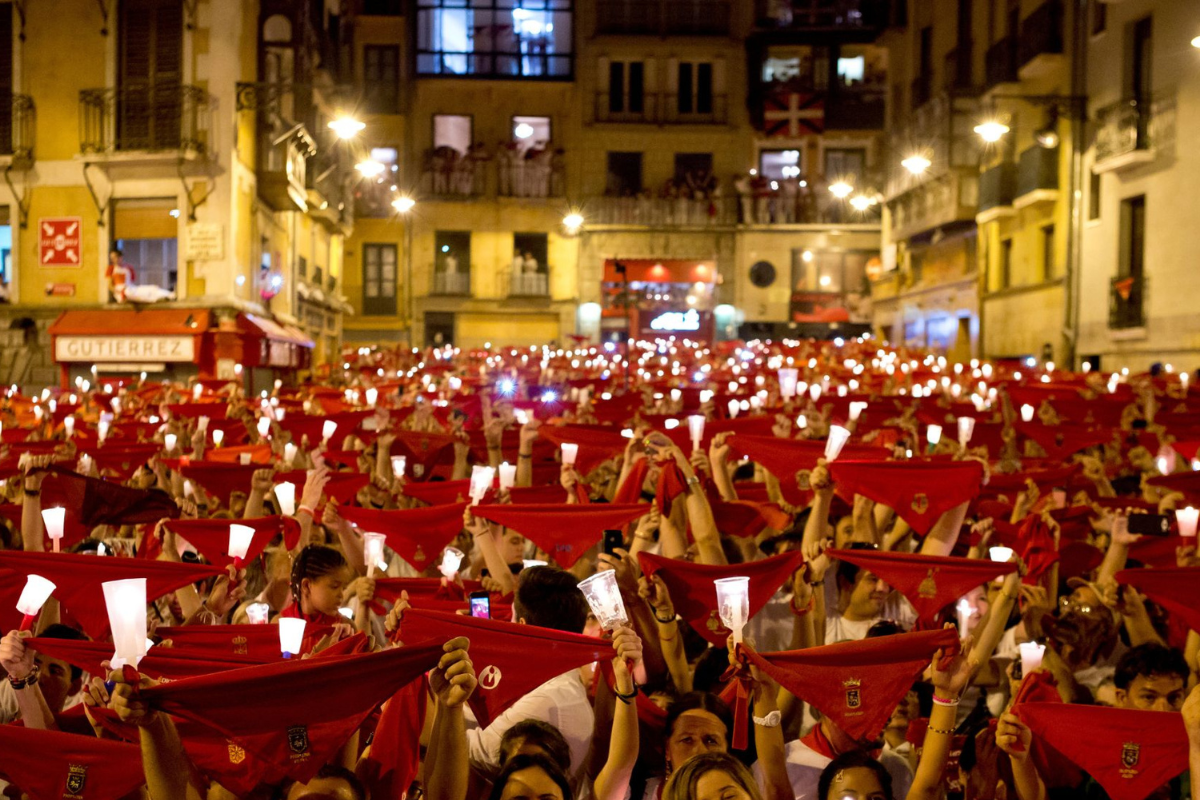
The End: Pobre de Mí
JULY 14 AT MIDNIGHT
At exactly midnight on July 14, the vibrant energy of San Fermín slows down for one final, emotional gathering: the Pobre de Mí ceremony. In a stark contrast to the explosive beginning of the festival, this closing event is quiet, reflective, and deeply moving. Locals and visitors meet once more in front of Pamplona’s City Hall, this time holding candles, as they sing the traditional song “Pobre de mí, pobre de mí, que se han acabado las fiestas de San Fermín” — “Poor me, the festival is over.”
The sea of candlelight, the gentle melody of the crowd, and the collective feeling of gratitude make this a moment that touches everyone present. For many, especially first-time visitors from abroad, it’s a powerful reminder of how meaningful this festival is to the people of Pamplona. This is not just the end of a party — it’s the end of a spiritual and cultural journey, shared with thousands of others who’ve come to love San Fermín in Spain.
If you’re an American traveler looking for more than just thrills, the Pobre de Mí ceremony offers a chance to connect deeply with the heart of the local community. It’s a moment to reflect, to give thanks, and to understand why Pamplona’s festival means so much to those who call it home. Don’t miss this unforgettable ending — it will leave you with goosebumps, and a desire to return.

